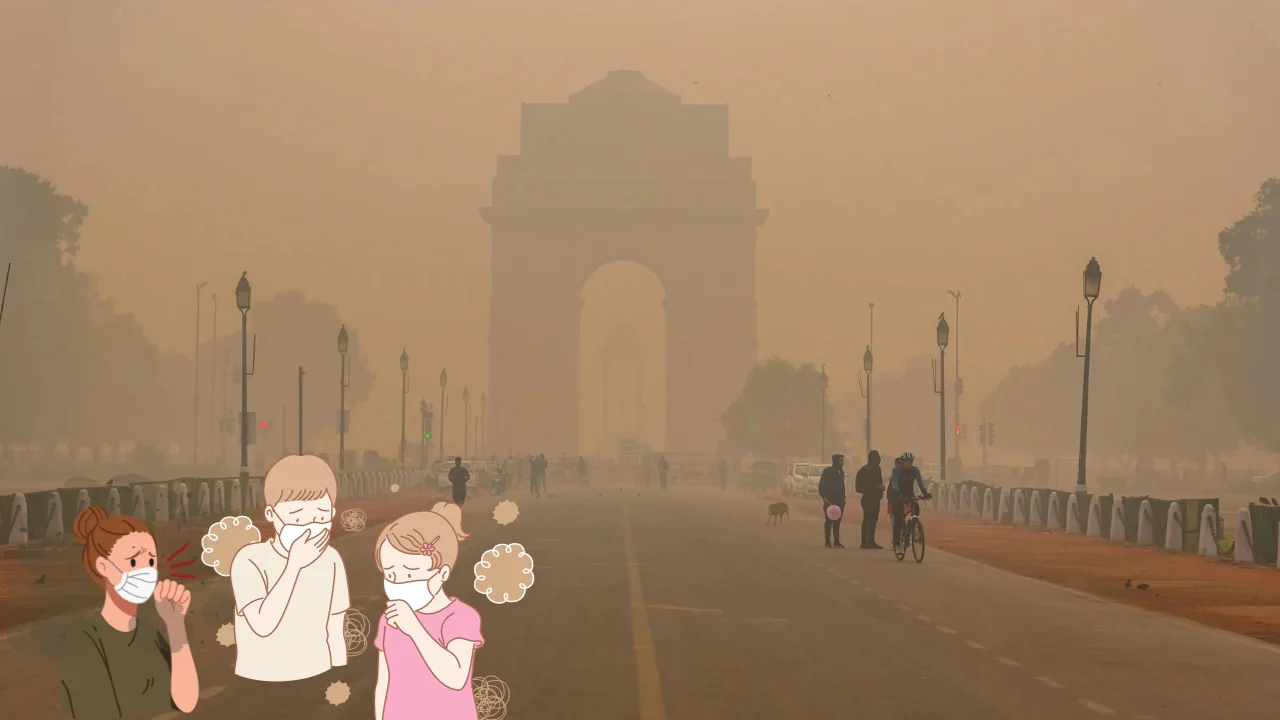Delhi Pollution
On the 2nd November morning, the air quality early warning system (EWS) for Delhi had initially forecasted that pollution levels would stay in the “very poor” category, with an Air Quality Index (AQI) figure of under 400, until the following week. However, by evening, Delhi’s air quality took a significant turn for the worse, reaching an AQI of 422 at 10 p.m. This unexpected deterioration in air quality led to a crisis for the EWS, highlighting the challenges of accurately predicting and managing air quality in the region.
About the Air Quality Early Warning System (EWS)
The air quality early warning system (EWS), developed by the Indian Institute of Tropical Meteorology (IITM) with the purpose of predicting when Delhi’s air might deteriorate, is designed to serve as the foundation for activating pollution-control measures.
The EWS is a part of the Ministry of Earth Sciences. It is executed by the IITM in collaboration with the India Meteorological Department (IMD). However, despite inquiries regarding the inaccurate forecast, there was no response from these agencies.
Notably, the EWS, along with two other agencies, was temporarily taken offline last month. This action was attributed to the need for standardizing forecasting practices since the different models used distinct nomenclature.
Air Quality EWS Failure
The fact that the EWS failed to anticipate the rapid decline in Delhi’s air quality on Thursday, missing the mark by four days, signifies that the city remains unprepared, much like in previous years. During previous crises, the response to worsening air quality has generally been reactive and often ineffective. This emphasizes the need for improved and more accurate air quality prediction systems to proactively address air pollution issues in the region.
How does the air quality Early Warning System work?
The air quality early warning system (EWS) offers daily assessments for a period of nine days, and it recalibrates its predictions every 24 hours. The EWS predictions serve as the basis for activating the graded response action plan (GRAP), recognizing that stopping polluting activities as early as possible is key to the effectiveness of these measures.
The lack of advanced warning by the EWS caught the Commission for Air Quality Management’s subcommittee on GRAP off guard. They had to hastily convene at 4.30 pm on Thursday as the haze thickened over Delhi, and pollution levels continued to rise. By that time, the AQI had already reached 392, up from 364 the previous day at 4 p.m. This delay in taking action highlights the need for more accurate and timely air quality predictions to facilitate proactive measures to combat air pollution.
Delhi Air Quality EWS Wrong Prediction
The intention behind revising the GRAP was to shift from a reactive to a pre-emptive approach. Previously, measures were implemented once the air quality reached a certain level. The idea was to act based on forecasts, but for this approach to work effectively, the forecasts need to be accurate as well.
However, the forecast issued on Thursday morning by the EWS indicated that the severe pollution level would only be breached between November 6 and 11. It suggested that Delhi’s air quality would remain in the ‘very poor’ category from November 3 to 5, with a subsequent outlook for the following six days indicating air quality ranging from ‘very poor’ to ‘severe.’ This discrepancy between the forecast and the actual situation underscores the importance of accurate and timely predictions for effective pre-emptive action.
Need to Upgrade
Mukesh Khare, a professor at IIT Delhi and a former member of the Commission for Air Quality Management (CAQM), suggests that the discrepancies between the forecast and actual air quality may be attributed to either an outdated emissions inventory or the need to recalibrate the model.
- Khare emphasized the importance of regularly updating the emissions inventory. It is a long-term database of emissions contributed by various sectors.
- To ensure accurate forecasts, this inventory should be updated every two years.
- He noted that he had recommended, as a CAQM member, the implementation of a uniform protocol for calculating emissions inventory to the Central Pollution Control Board (CPCB). This would help enhance the accuracy of air quality forecasts and pollution control measures.
Mukesh Khare pointed out that agencies and states often calculate emissions inventories in their own way, lacking a fixed protocol for consistency in these calculations.
Modelling Frameworks used by early warning system
The EWS forecasts rely on two modeling frameworks.
- One is based on the National Center for Atmospheric Research’s (NCAR) atmospheric chemistry transport model, and the other is based on a model from the Finnish Meteorological Institute.
- These models are combined and incorporate a data assimilation facility that receives information from satellites regarding dust aerosols, particulate matter from crop stubble burning, and other air pollutants like SO2 and NO2.
- This multi-model approach is aimed at providing more accurate air quality forecasts.
The modeling frameworks used by the air quality EWS take various factors into account. These include background aerosols and pollutants, long-range transport of dust from dust storms, and particulate matter stemming from agricultural fires.
Enhanced anti-pollution curbs expected amid worsening air quality in Delhi
As Delhi’s air quality deteriorates, the Commission for Air Quality Management (CAQM) has scheduled a meeting at 1:30 p.m. on Friday to discuss the possibility of invoking Stage 4 of the Graded Response Action Plan (GRAP). This would lead to enhanced anti-pollution measures to address the worsening air quality, which entered the severe category for the first time this season on Thursday.
At 11 a.m., the average AQI for Delhi stood at 475, surpassing its peak levels from the previous year (450) and 2022 (471). In 2020, it was 477, and in 2019, it reached 494. Two monitoring stations, Mundka and Punjabi Bagh, recorded an AQI of 499. With farm fires not yet at their peak, the air quality is expected to deteriorate further. This situation underscores the need for immediate action to combat air pollution.
Reasons behind Rising Pollution Levels in Delhi during Winters
Stubble Burning
Stubble burning is a common practice among farmers in Punjab and Haryana to clear crop residues from their fields in preparation for the next season. However, this practice generates a significant amount of smoke and particulate matter, which is carried by the wind to Delhi and other parts of northern India.
- According to the System of Air Quality and Weather Forecasting and Research (SAFAR), in 2021, stubble burning contributed to 25% of Delhi’s pollution.
- Stubble burning releases various toxic pollutants into the atmosphere. It includes harmful gases like Carbon Monoxide (CO), methane (CH4), carcinogenic polycyclic aromatic hydrocarbons, and volatile organic compounds (VOCs).
- These pollutants have adverse effects on air quality and public health, contributing to the worsening pollution levels in the region.
Wind Direction
Wind direction is a crucial factor in Delhi’s air pollution, particularly during the winter months. Post-monsoon, the prevailing wind direction in Delhi is northwesterly. These winds carry dust and smoke into the city when crop residue is being burned in Haryana and Punjab.
- According to a study conducted by the National Physical Laboratory, approximately 72% of Delhi’s winter winds originate from the northwest.
- When the wind direction changes, it can prevent these pollutants from being transported into the city.
- For instance, on October 25, 2023, there was a marginal improvement in air quality when the wind shifted from the north to the northeast.
- This change in wind direction can have a significant impact on air quality in the region.
Temperature Inversion
Temperature inversion is a meteorological phenomenon where the air temperature increases with altitude, contrary to the typical decrease with higher elevation. This results in a layer of warm air above a layer of cold air, effectively trapping pollutants near the ground.
- Temperature inversion has a significant impact on Delhi’s pollution, particularly during the winter months when the weather is cold and calm.
- During this time, pollutants from various sources, including crop residue burning, vehicle emissions, industrial emissions, and others, accumulate in the lower atmosphere.
- The temperature inversion creates a stable layer of warm air above, preventing the pollutants from dispersing.
- This leads to the formation of a dense layer of smog, further exacerbating air quality issues in the region.
Dry and Still Air
During the winter months, Delhi experiences dry and still air conditions. This weather pattern is characterized by reduced rainfall and low wind speeds. These conditions have a significant impact on air quality because pollutants are not effectively washed away or diluted by fresh air.
- In such situations, pollutants remain suspended in the atmosphere for longer periods of time.
- This lack of air movement allows pollutants to accumulate and persist, contributing to the deterioration of air quality in the region.
- The combination of dry and still air, temperature inversion, and other factors often lead to prolonged episodes of poor air quality during the winter season in Delhi.
Vehicular and Industrial Emissions
Vehicular and industrial emissions are significant sources of air pollution in Delhi. The city’s large population and high number of vehicles contribute to the release of harmful gases and particles into the atmosphere. Additionally, industries in and around Delhi play a role in pollution by burning fossil fuels and emitting various chemicals into the air.
- A study conducted by the Indian Institute of Technology (IIT) Delhi found that vehicular emissions contribute to approximately 25% of Delhi’s PM2.5 levels.
- PM2.5 refers to fine particulate matter that poses serious health risks when inhaled.
- Addressing these emissions from vehicles and industries is a crucial aspect of mitigating air pollution in the city.
Dust storms, Firecrackers, and Domestic Biomass Burning
In addition to the previously mentioned factors, there are several other sources of pollution that become more pronounced during the winter months in Delhi:
- Dust storms: Dust storms carry dust particles from arid regions into the city, adding to the particulate matter in the air.
- Firecrackers: The burning of firecrackers during festivals like Diwali produces smoke and releases metals into the atmosphere, contributing to pollution.
- Domestic biomass burning: Many households in and around Delhi use biomass, such as wood or crop residues, for heating during the winter. This practice adds to the levels of carbon monoxide and particulate matter in the air.
A 2015 study conducted by the Indian Institute of Technology (IIT) Kanpur found that 17-26% of all particulate matter in Delhi during the winter is attributed to biomass burning. These additional sources of pollution further compound the air quality challenges faced by the city during the winter season.
- Weekly Current Affairs 2025 PDF For Bank, SSC, UPSC Exams
- Unsung Heroes of India: 10 Unknown Freedom Fighters You Should Know
- 26 December Current Affairs 2023 in English
- Daily Current Affairs 2025, Check Today’s Current Affairs
- April Month Current Affairs 2024, Download PDF
- June Month Current Affairs 2024, Download PDF

Hello, I’m Aditi, the creative mind behind the words at Oliveboard. As a content writer specializing in state-level exams, my mission is to unravel the complexities of exam information, ensuring aspiring candidates find clarity and confidence. Having walked the path of an aspirant myself, I bring a unique perspective to my work, crafting accessible content on Exam Notifications, Admit Cards, and Results.
At Oliveboard, I play a crucial role in empowering candidates throughout their exam journey. My dedication lies in making the seemingly daunting process not only understandable but also rewarding. Join me as I break down barriers in exam preparation, providing timely insights and valuable resources. Let’s navigate the path to success together, one well-informed step at a time.






